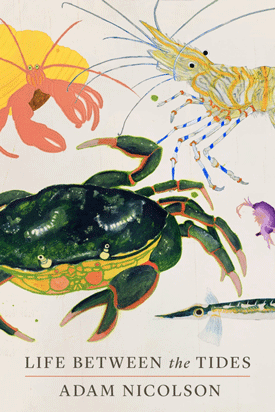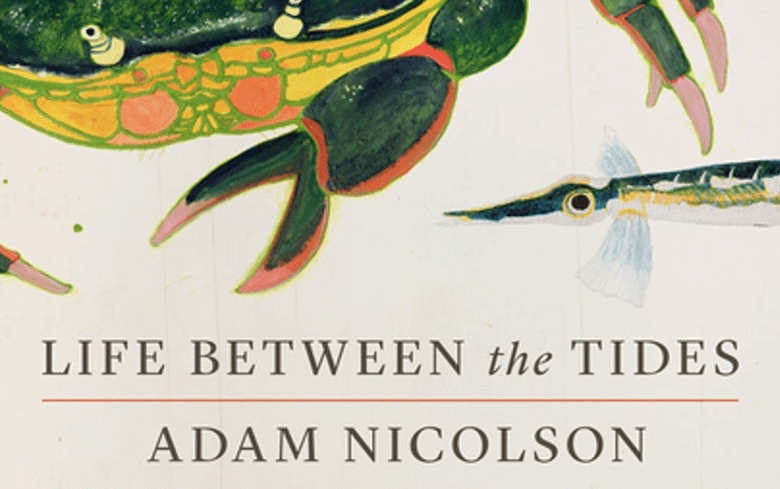Life Between the Tides
By Adam Nicolson (2021)
Review by Tina Cohen
Adam Nicolson is a British writer with who’s written on history, landscape, and literature, so it is no surprise that his book seemingly focused on coastal ecology— life between the tides—would include those other interests as well.
He begins with an introduction to the bay, part of the Sound of Mull, where a seasonal home of his in-laws is located in Argyll, Scotland. His reconnection there after each absence is a ritual, going down to the rocky beach and wading into the shallows.
“This is the world of flux and if I stand still in those shallows for a minute I am surrounded by the flitter and skitter of life,” he writes.

His poetic cataloging of sea life there follows and serves to introduce readers to what will be looked at in closer detail in chapters to come. There are the mounds of seaweed on the beach; “they look like piles of day-old salad.” And a “barnacle-encrusted rock, a bruised and battered lump of the ancient rocks brought here by the glaciers…”
In the water, he sees “all kinds of resilient and defended creatures,” including hermit crabs, winkles, whelks, the brown shrimp Crangon crangon, and various small fish, including the common goby and the dab.
In the thick kelp fronds, “the most unlikely drawing-room colors erupt on a damp Scottish coastline. The coralline makes a vermilion mat where the limpets dig their nests. Venetian-striped top shells crawl between the dried-blood red of the beadlet anemones. Bright yellow and green sponges line the polychrome pools.”
Notable are pink-fleshy starfish, purple-black giant anemones, and the invasive green crab, “blotched and mottled, with a whole night sky of spots and patches on his carapace.”
He’d asked for government approval of his small-scale project and was a bit miffed at their response…
Well-versed in the literature of poets and philosophers, Nicolson includes the likes of Emily Dickinson, T.S. Eliot, Shakespeare, Homer, Seamus Heaney, Walt Whitman, William Wordsworth, Socrates, Plato, and Heidegger. But his main focus is researching scientific history and studies drawn from marine biologists past and present, in service of building three tidal pools on his shoreline.
He’d asked for government approval of his small-scale project and was a bit miffed at the response—unimpressed consent, with a comparison of its likely impact to children’s play.
Nicolson’s view was that he was building habitat as a laboratory, a place for observation and inspiration. His study of the pools and relevant data led to appreciating what experts had elucidated: for example, prawns are able to feel anxiety, green crabs are tender and solicitous in their mating, and sea urchins and periwinkles can smell ripped flesh and thereby escape when one of their own is being injured.
These are only a few of the chapters. From ancient shell middens and sacrifices to the god of the sea to modern-day oil spills and climate change, most of his subjects, though set in Scotland, will resonate with readers more familiar with Maine’s coast.
The book is full of maps, graphs, drawings, and color plates with helpful captions, and while some of the information—for a lay person—can be dense and challenging, I’ll suggest that the overall experience, making your way through the book, will be worthwhile even if there are some momentary struggles (there were for me) with uncertain understanding or feeling buried by excessive detail.
My advice: don’t expect to understand everything. Accept the author’s sense of adventure, his playing with ideas and language. Here’s Nicolson metaphysically musing about his project, perhaps with a relevant warning about his book as well:
“To make a rock pool was in fact to make something no less complex than the ocean itself. But here is the dizzying part. Fractal theory suggests that the closer you look at something, the more it remains unknown. Knowledge cannot embrace what it seeks to know. It can only sit alongside the world, contingent, touching it, maybe, at one or two points but shrinking beside the unaddressable and limitless actuality of things.
“The rock pool was not going to be a tiny, graspable fragment of the universe. It was going to be as unknowable as the universe itself.”
Tina Cohen is a seasonal resident of Vinalhaven.





